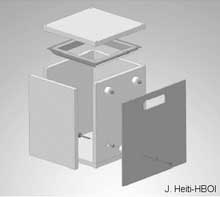
3-D drawing of the BioBox. The special insert below the lid is designed to ensure that the lid forms a watertight seal when closed. The two valves on the side of the box are pressure relief valves, put in place so that the box doesn’t explode as pressure decreases (and gas bubbles in water expand) on the ascent to the surface.
Animal Capture – the Bio-Box
Tamara Frank, Ph.D.
Biological Oceanographer
Harbor Branch Oceanographic Institution
As discussed on the Operation Deep-Scope 2004: Capturing Benthic Animals essay, deep-living benthic shrimp are very difficult to bring up alive and with intact eyes. On Deep-Scope 2004, we used traps composed of PVC to attempt to capture some of these elusive creatures. While the traps had funnels at both entrances, the design of the door closures enabled the shrimp and crabs to leave the traps, rather than being “trapped” inside. An important component of the trap design was that the trap was closed and sealed before the submersible returned to retrieve them. Therefore, the doors had to swing closed from the inside (to prevent sand and grit from being caught in the o-ring seal, as would occur with doors swinging closed from the outside). Apparently, the bars and gears required for this operation also provided “ladders” that the crustaceans were able to use to climb out of the traps. Therefore, while the traps proved to be very adept at capturing the disgusting hagfish, the catch success for crustaceans was very low.
This year, in addition to deploying slightly redesigned traps, animal capture will also be attempted with a small shrimp trap, constructed of hardware cloth using standard designs. With this open design, we anticipate a much better capture rate, but we run into the problem of the shrimp being blind and/or dead when the trap is brought to the surface. Therefore, a “Bio-Box” is being constructed of 1 inch thick black Plexiglas that will fit in the collecting box on the front of the Johnson-Sea-Link (JSL). The lid of the Bio-Box is being designed such that it will be sealed and water-tight when closed, and can be closed using the hydraulics on the JSL, so that any organisms inside will be protected from temperature changes and light on the trip to the surface. The open shrimp trap will be deployed in the same region as the PVC shrimp traps, which contain pingers to aid in their location by the submersible. On a subsequent dive, the traps will be located with the aid of the pingers, and once the submersible is in the vicinity, all lights will be extinguished with the exception of one light filtered with a SCHOTT OG590 cutoff filter. This filter lets through light at wavelengths greater than 590 nm, which is at the red end of the spectrum, and to which deep-sea species are very insensitive. Under this red light, the open shrimp trap will be retrieved with the claw of the submersible and placed in the Bio-Box, which will then be closed, protecting the animals in the trap from submersible lights during the rest of the dive, or daylight on the trip to the surface. The PVC traps will be placed in the remaining space in the collecting box, as they are closed and sealed off from extraneous light or temperature changes.


























